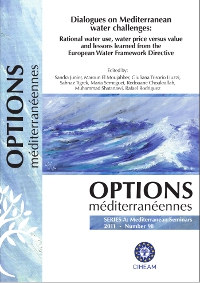| Article précédent | p. 119-128 | Article suivant |
What is covered by water fees, prices and costs? Examples of water policies in Turkey
The paper discusses what is understood as water price in Turkey, the components it comprises of, the methods of pricing and the advantages and disadvantages of these methods. The methods used for pricing drinking and irrigation water in Turkey are explained with examples. The structure of financing, construction, operation and maintenance is described. The question is raised whether the price for water should always cover all the costs. International organizations promote full cost recovery, but the paper demonstrates that economic, social and geographic conditions should be taken into account when setting the price. Full cost recovery can severely hinder public access to clean drinking water, specifically for the poor, because the water price may be too high compared to their income. In irrigated agriculture it can lead to the abandonment of irrigation when the water is too expensive compared to the value of the crops produced. Therefore the use of a socio-economical development index is proposed. This index helps in determining what share of the full costs can reasonably be included in the price. In addition the price may include a stimulus for water saving by using tiered pricing: the price increases with the amount of water used.
Ce document de réflexion porte sur la notion de tarif de l'eau en Turquie, sur les composants de ce tarif, sur les méthodes de tarification et sur les avantages et inconvénients de ces méthodes. Il décrit l'organisation du financement, de la construction, du fonctionnement et de l'entretien. La question posée est de savoir si le tarif de l'eau doit toujours couvrir tous les coûts. Les organisations internationales recommandent un recouvrement intégral des coûts, mais cette étude entend démontrer que la tarification doit prendre en compte les conditions économiques, sociales et géographiques. Le recouvrement intégral des coûts peut gravement entraver l'accès à l'eau potable, en particulier pour les plus démunis, si le prix de l'eau est trop élevé par rapport aux revenus. Dans l'agriculture irriguée, il peut entraîner l'abandon de l'irrigation si l'eau devient trop chère en comparaison avec la valeur des récoltes. L'instauration d'un indice de développement socio-économique est par conséquent proposée. Cet indice aide à déterminer la part des coûts réels pouvant être raisonnablement incluse dans le tarif. En outre, le prix peut servir d'outil d'économie de consommation d'eau au moyen d'une différenciation de la tarification : le prix monte au fur et à mesure que la consommation augmente.
- [ Afficher ]
- [ Télécharger ]
- [ Exporter la citation ]
Vous pouvez télécharger la citation au format :
- [ Imprimer ]
-
Mots-clés
COUT, EAU, FIXATION DES PRIX, INDICATEUR DE DEVELOPPEMENT, IRRIGATION, POLITIQUE DES PRIX, TURQUIE, VALEUR ECONOMIQUECiter cet article
Demir H., Zahir Erkan A., Karaca Bilgen G. What is covered by water fees, prices and costs? Examples of water policies in Turkey. In : Junier S. (ed.), El Moujabber M. (ed.), Trisorio-Liuzzi G. (ed.), Tigrek S. (ed.), Serneguet M. (ed.), Choukr-Allah R. (ed.), Shatanawi M. (ed.), Rodríguez R. (ed.). Dialogues on Mediterranean water challenges: Rational water use, water price versus value and lessons learned from the European Water Framework Directive. Bari : CIHEAM, 2011. p. 119-128. (Options Méditerranéennes : Série A. Séminaires Méditerranéens; n. 98). 3. MELIA Workshop Water Value Impacts on the Mediterranean Water Policies, 2009/03/21-23, Istanbul (Turkey); 4. MELIA Workshop Benchmarking Exercise and Recommendations on the Application of the Water Framework Directive, 2010/03/21-26, Amman (Jordan). http://om.ciheam.org/om/pdf/a98/00801474.pdf



